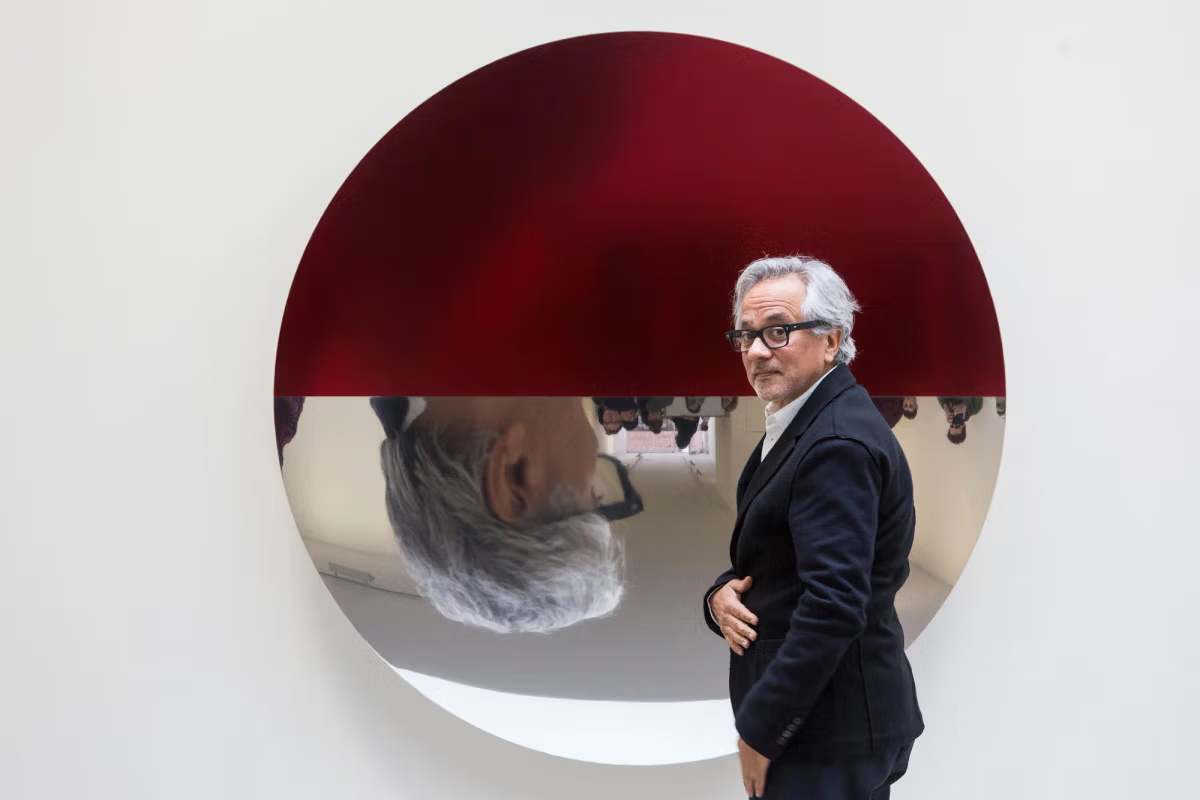Anish Kapoor is a world-renowned artist celebrated for his perception-defying sculptures and large-scale public installations. His work challenges conventional ideas about physical space and evokes the metaphysical. Kapoor’s art is full of paradoxes, such as the interplay between materiality and immateriality, presence and absence, and the relationship between the human body and spirit. He has achieved iconic status globally due to his ability to create experiences that elicit both collective awe and private contemplation. His works are permanently featured in major museums worldwide, including the Museum of Modern Art in New York, the Tate in London, and the Guggenheim Museums in Venice, Bilbao, and Abu Dhabi. Kapoor is a pivotal figure who continually challenges the definition of sculpture, navigating both critical acclaim and significant controversies.
Kapoor’s artistic approach is a deliberate philosophical inquiry into the nature of reality. This is often influenced by Eastern concepts, particularly the notion of “Maya,” which refers to illusion. By manipulating the perception of space and form, Kapoor prompts viewers to question the reality of their own perceptions. His art, therefore, moves beyond formal sculpture into the realm of metaphysical exploration.
Roots and Early Explorations
Anish Kapoor was born in Mumbai, India, in 1954, to parents of Punjabi and Iraqi-Jewish heritage. This multicultural upbringing exposed him to a “cultural melange” from an early age. After attending The Doon School in India , he moved to London in the early 1970s to study at Hornsey College of Art and later at the Chelsea School of Art and Design. His multicultural background profoundly shaped his artistic vision, and the blend of Eastern and Western traditions manifests as a pervasive dualism throughout his works. The exploration of concepts like lightness and weight, or interior and exterior, stems directly from his cross-cultural identity.
A significant influence during his studies was the artist Paul Neagu, who helped Kapoor articulate the cross-cultural artistic vision that would form the foundation of his career. Kapoor’s foundational series, “1000 Names” (1979–80), marked his initial rise to prominence. This series featured simple geometric forms covered in bright, powdered pigments that often spilled onto the surrounding surface. This practice was inspired by the vibrant mounds of pigment he saw in Indian markets and temples. The pigment’s ability to “spill” or “permeate” the surrounding space was a critical conceptual move, as it deliberately dissolved the traditional boundary between the art object and its environment. This early work foreshadowed his later, larger-scale works that directly manipulate space and perception. It challenged the Western sculptural tradition of the self-contained, finite object, inviting a more fluid relationship with space where the object appears “partially there”. This innovative approach led to his association with the “New British Sculptors” group, which included artists such as Tony Cragg and Antony Gormley.
The Evolution of a Vision: Void, Reflection, and Scale
Kapoor’s work evolved from his early pigment pieces to sculptures that explored cavities and negative space. A notable example is Void Field (1989), which won the Premio Duemila Prize at the 44th Venice Biennale. This installation featured sandstone blocks with holes filled with black pigment, exploring the tensions between presence and absence. For Kapoor, the void is not silent emptiness but a “transitional space” that conveys the “unknown and intangible”. His exploration of the void expanded with monumental installations like Marsyas (2002) at Tate Modern, a colossal, trumpet-like structure of red PVC membrane that spanned 150 meters and invited visitors to “literally enter the void”. Other works, such as Descension (2014) and Descent into Limbo (1992), create illusions of endless abysses and swirling vortices. These “void” works are designed to induce a profound perceptual and psychological experience, compelling the viewer to confront the limits of their perception.
Beginning in the mid-1990s, Kapoor’s practice increasingly featured highly polished, reflective surfaces. Works like Her Blood (1998) and Blood Mirror (2000) use concave stainless steel discs that reflect and contort reality, subverting the viewer’s sense of perception. His most famous public work, Cloud Gate (2004) in Chicago’s Millennium Park, is a 110-ton elliptical archway of polished stainless steel that reflects and distorts the city skyline. The sculpture features an “omphalos” (navel), a concave chamber on its underside that warps and multiplies reflections. These reflective sculptures, which include other works like Sky Mirror (2006), function as dynamic, interactive canvases that democratize the art experience. The widespread “selfie phenomenon” around Cloud Gate is a significant outcome that shows how Kapoor’s work influences contemporary cultural behaviors, blurring the lines between art, public space, and personal identity.
Kapoor’s experimentation with diverse materials, from natural stone and wax to industrial steel and PVC, is central to his work. Each material choice deepens his exploration of dualities and the concept of “Maya”. His wax sculptures, such as My Red Homeland (2003) and Svayambh (2007), use mechanized movement to shift large masses of red wax through spaces, highlighting themes of temporality and transformation. In contrast, his stone works, like Untitled (2018), transform a material of permanence into one that evokes weightlessness and immateriality. The deliberate selection of materials elevates the physical object into a metaphor for existential conditions, allowing his work to resonate on a primal, human level. Kapoor also uses bold colors like red and blue, which are imbued with cultural meanings, red evoking vitality and blue suggesting infinity.
Navigating the Public and the Polemical
Anish Kapoor’s career has been marked by significant public controversies, often stemming from his material choices and engagement with the public sphere. The most prominent of these is the Vantablack controversy, which began in 2016 when Kapoor acquired the exclusive artistic rights to Vantablack, a material that absorbs 99.965% of visible light. This sparked widespread controversy in the art world, with many critics arguing that it limited access to a groundbreaking material. The dispute escalated into a public “color war” with artist Stuart Semple, who created his own ultra-saturated pigments, including “Pinkest Pink,” which he sold with the stipulation that Kapoor was prohibited from purchasing them. Kapoor responded by posting an image of his middle finger covered in Semple’s “Pinkest Pink” on Instagram. The Vantablack controversy illuminates fundamental ethical questions about artistic ownership and the commercialization of scientific innovation in art. While some argue that Vantablack’s dangerous and delicate nature justifies the exclusivity, the perception of “color hoarding” persisted. The debate became a discussion about the “legitimacy of patents” in art and whether restricting access constitutes a form of censorship.
Public art has also placed Kapoor under scrutiny, notably with the vandalism of Dirty Corner at Versailles in 2015. After Kapoor was misquoted as referring to the colossal steel and rock sculpture as “the queen’s vagina,” the piece was repeatedly vandalized with anti-Semitic slogans. Kapoor, whose mother is Jewish, made the controversial decision to leave the graffiti on the sculpture to “highlight intolerance in France”. This decision led to a court case where a politician sued Kapoor for displaying hateful words in a public space. The court ultimately ruled that the offensive words had to be removed or covered to maintain “public peace over artistic scandal”. Kapoor’s act transformed the artwork into a living document of societal intolerance, demonstrating the artist’s role as a provocateur and a mirror to uncomfortable truths.
More recently,
Cloud Gate was the subject of the “Man in the Bean” satire in 2024, a social media hoax that claimed a man had been trapped inside the sculpture since its construction. This satirical campaign underscored the sculpture’s immense cultural penetration and iconic status, demonstrating how its reflective and sealed-off nature makes it an “accommodating vessel for satire and conspiracy theories”. Kapoor has also taken a strong stance against the misuse of his public art, as seen in his dispute with the NRA in 2018, where he condemned their use of Cloud Gate in an advertisement.
Kapoor’s philosophy on the artist’s role is intertwined with his controversial actions. He believes that artists must “refuse to play the game” of capitalism and the market. His studio wall famously bears the words: “disobey, disavow, disagree”. This philosophy explains his confrontational actions, such as his refusal to conform to the open-source ethos of some art communities in the Vantablack dispute, or his decision to leave the graffiti on Dirty Corner as a direct act of “disavowal” of censorship. For Kapoor, these controversies are not distractions but integral extensions of his artistic practice, fulfilling his belief that art should engage with the “half known” and challenge societal assumptions.
Market and Institutional Footprint: A Global Presence
Anish Kapoor’s standing is underscored by a multitude of prestigious awards and honors, including the Turner Prize in 1991 and a knighthood in 2013. Despite his “disobedient” persona, he is deeply integrated into and celebrated by the very institutional structures he critiques. This dynamic allows him to operate from a position of immense influence. Kapoor’s global presence is further evidenced by his representation by leading galleries such as Lisson Gallery and Galleria Continua. His works are permanently exhibited in prestigious institutions worldwide and are consistently acquired by prominent museums. For example, the Kröller-Müller Museum recently acquired Untitled (2018), a 400-kilogram stone sculpture that explores the void.
Kapoor also has a strong secondary market performance, with his works consistently commanding high prices at auction. The market for his art is robust, with a high sell-through rate and an average sale price of $265,000. The strong market performance, despite his controversies, suggests that the art market values not just the aesthetic object but the intellectual discourse and cultural impact surrounding the artist’s practice. The “polemical” aspects contribute to his visibility and perceived importance, making his works more desirable as cultural artifacts that embody contemporary debates.
Anish Kapoor’s Enduring Legacy and Future Horizons
Anish Kapoor has profoundly redefined sculpture, consistently challenging perception and infusing monumental works with deep philosophical meaning. His legacy lies in his ability to make the intangible tangible and the familiar unfamiliar. He consistently deconstructs the “object reality” of sculpture, creating experiences that dissolve the boundaries between object and space. This transforms the act of viewing into a meditative or disorienting journey for the viewer. Kapoor’s artistic journey is characterized by an ongoing commitment to exploration, particularly his relentless pursuit of new materials and technologies. His willingness to embrace scientific and technological advancements, as seen with his ongoing work with Vantablack, ensures his work remains at the vanguard of contemporary art. The enduring power of Kapoor’s art also lies in the continued relevance of his core themes, the void, duality, and the human experience. By tapping into universal existential questions and exploring concepts like “Maya” through abstract forms, his works become universally accessible metaphors for the complexities of existence. This allows his art to remain relevant and thought-provoking across diverse audiences and evolving cultural contexts, ensuring his lasting impact.









